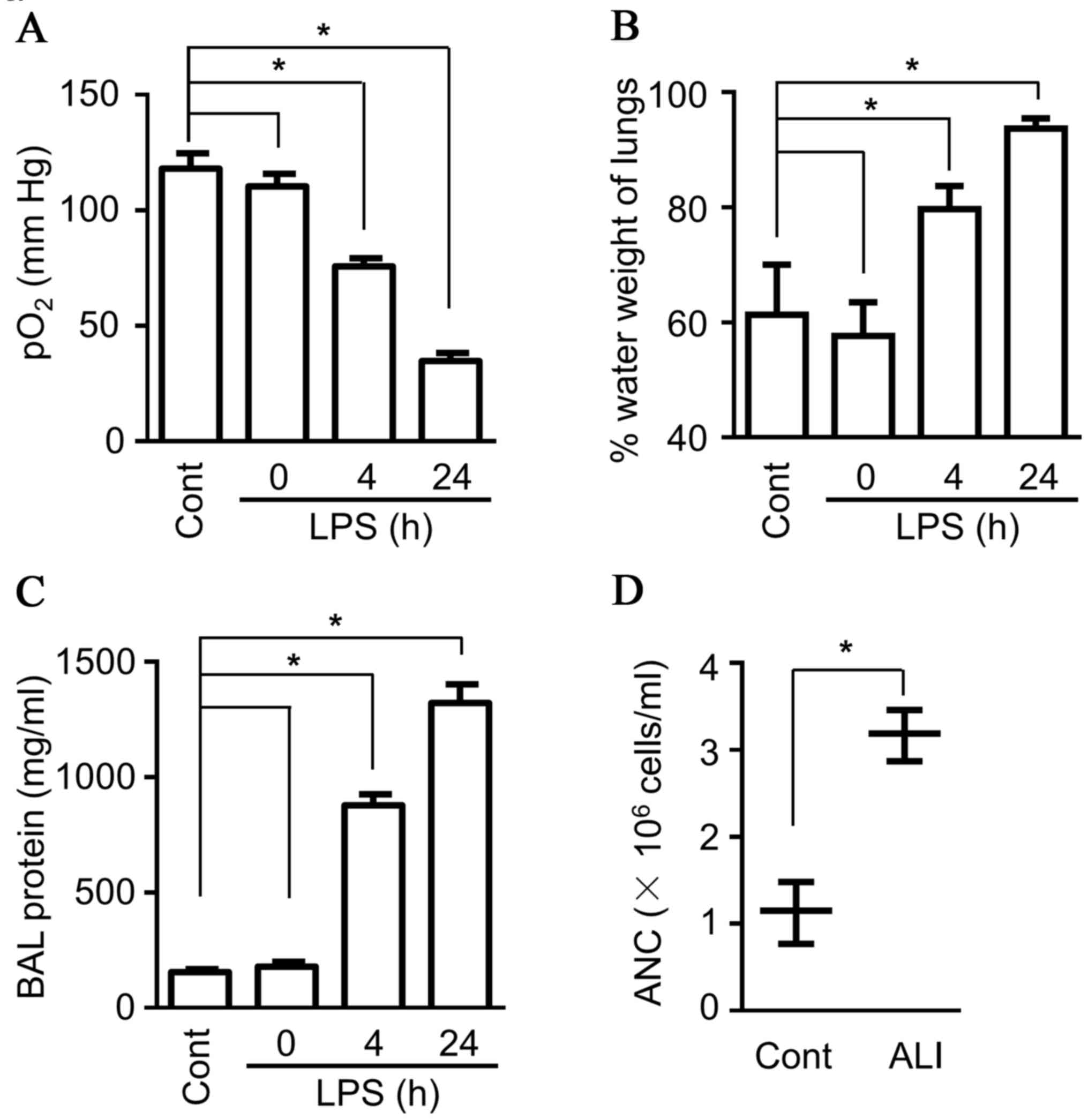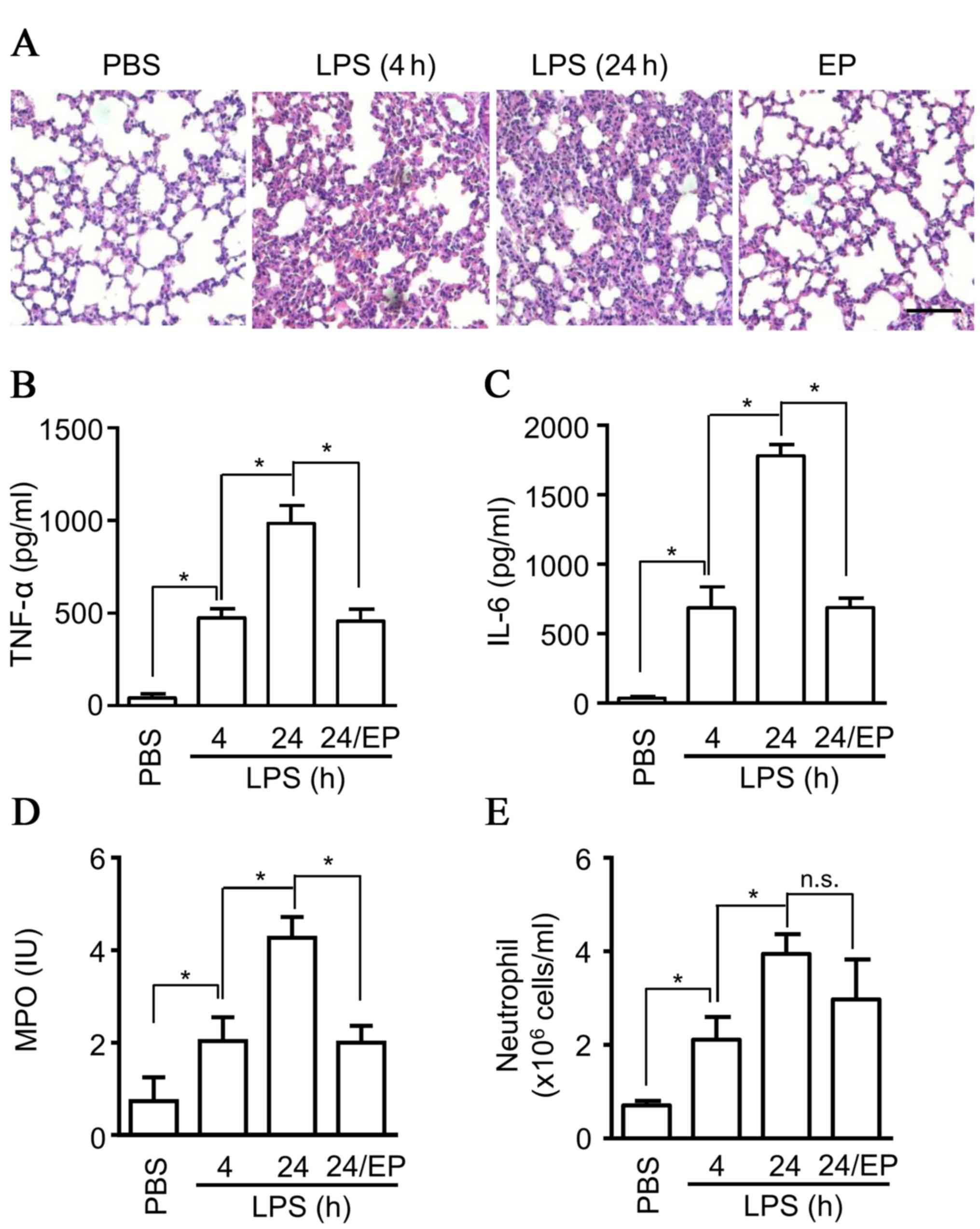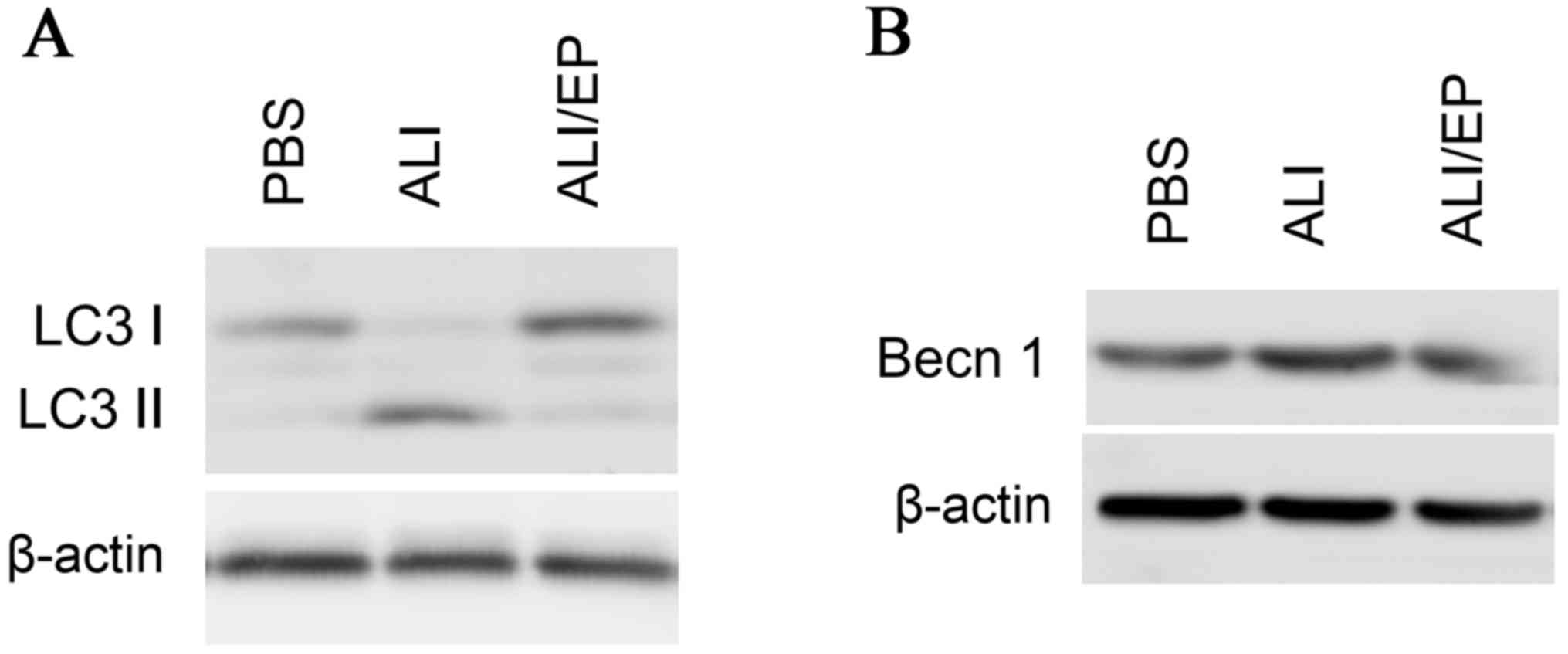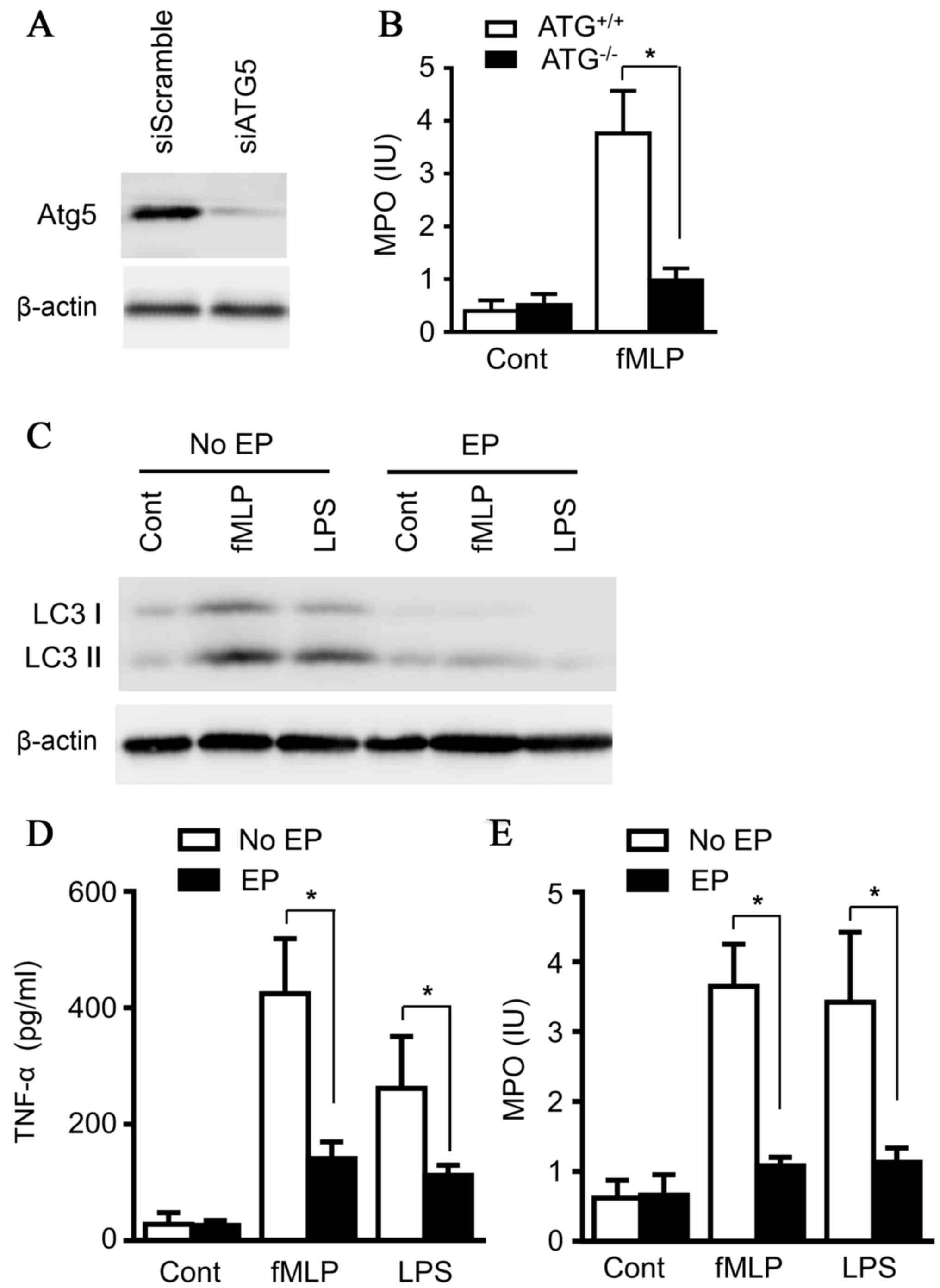Protective effects of ethyl pyruvate on lipopolysaccharide‑induced acute lung injury through inhibition of autophagy in neutrophils
- Authors:
- Published online on: January 13, 2017 https://doi.org/10.3892/mmr.2017.6118
- Pages: 1272-1278
-
Copyright: © Zhu et al. This is an open access article distributed under the terms of Creative Commons Attribution License.
Abstract
Introduction
Numerous clinical events, including sepsis, trauma, transient ischemia and reperfusion, cause acute lung injury (ALI) (1). Sepsis, as a result of severe infection, is one of the most common clinical causes of ALI and leads to a high mortality of 60–80% (2). Although the management of critically ill patients is improving, the mortality rate remains ~40%, and survivors often do not return to a normal life (3). In both immunocompromised and immunocompetent individuals, bacterial pneumonia is a leading cause of mortality from ALI. During the process, neutrophil infiltration is the first event, followed by large amount of proinflammatory cytokines and proteases, including myeloperoxidase (MPO), which are the main mediators in the causes of serious lung injury. Presently, only a few pharmacological treatments are available for lipopolysaccharide (LPS)-induced ALI; the inhibition of inflammation or the production of antioxidative effects.
Ethyl pyruvate is a stable and simple lipophilic ester derived from the endogenous metabolite pyruvate and has been demonstrated to protect against inflammation and to mitigate organ dysfunction in several animal models of various disorders, including severe sepsis, burns and acute pancreatitis. Ethyl pyruvate has also been demonstrated to possess a protective effect on ALI, probably through the inhibition of the mitogen-activated protein kinase (MAPK) pathway in lungs (4,5). However, these results simply reveal the general ameliorative effect of ethyl pyruvate with no cellular target and therefore, more data are required to elucidate the underlying mechanism.
Previous studies (6–9) have demonstrated that neutrophils extensively accumulate in the lung during the initial stage of ALI, which substantially contributes to the severity of this disorder in human and animal models by several mechanisms: i) The release of granule components, including serine proteases, matrix metalloproteinases and lactoferrin; ii) the generation of reactive oxygen species; and iii) the formation of neutrophil extracellular traps, thus making neutrophils a potential target for ALI attenuation. Different therapeutic approaches have been developed against neutrophil infiltration, the releasing of granule components and the induction of apoptosis.
Autophagy is a constitutive regulatory means of cellular homeostasis involved in diverse physiological and pathological events (10–15). Autophagy has been demonstrated to be important for bacterial infection and inflammation (16–18), for example, autophagy in macrophages is important for the maturation, activation, polarization and regulation of cytokine production (19–23). Several mechanisms of anti-inflammation by autophagy have been proposed, including clearing the cytoplasm of non-functional organelles (e.g., mitochondria), and removing the aggregated inflammasome structure (16). However, few studies exist on the regulation of neutrophils by autophagy, and recently it was demonstrated that autophagy deficiency reduced neutrophil degranulation (24). Whether ethyl pyruvate contributes to neutrophil autophagy in ALI remains to be elucidated.
The present study aimed to confirm the protective effects of ethyl pyruvate on ALI in vivo using an LPS-induced mouse model, and to further elucidate the underlying mechanism. The data demonstrated that neutrophils infiltrated into airspace during ALI experience increased autophagy, which is required for granule release, while ethyl pyruvate inhibited autophagy in neutrophils, and decreased granule release, thus attenuating lung injury in ALI. This novel mechanism illuminates the role of ethyl pyruvate in ALI, and provides a basis from which to develop a novel therapeutic approach with autophagy as a target.
Materials and methods
Reagents and antibodies
Ethyl pyruvate, lipopolysaccharide and N-Formyl-Met-Leu-Phe were obtained from Sigma-Aldrich (Merck Millipore, Darmstadt, Germany). Antibodies against LC3 (cat. no. 4108S, 1:2,000), Becn1 (cat. no. 3738S, 1:2,000), ATG5 (cat. no. 12994, 1:2,000), and β-actin (cat. no. 4970S, 1:2,000) were obtained from Cell Signaling Technology, Inc. (Danvers, MA, USA). PE-Ly6G [1A8] and APC-Gr1 [RB6-8C5] were purchased from BioLegend, Inc. (San Diego, CA, USA). ELISA Kits for tumor necrosis factor-α (TNF-α), interleukin-6 (IL-6) and MPO were purchased from R&D Systems, Inc. (Minneapolis, MN, USA).
Experimental model
C57BL/6 male mice (n=56; 8 weeks old) used for preparing ALI models were obtained from the Shanghai Laboratory Animal Center of the Chinese Academy of Sciences (Shanghai, China), and maintained under specific pathogen-free conditions at 22°C, 50% humidity and a 12 h light/dark cycle, with free access to food and sterile water. The animals were weighed, injected intratracheally with LPS (5 mg/kg) or vehicle (phosphate-buffered saline; PBS) and euthanized with CO2 at 2 l/min in a closed box of ~10 l volume. The concentration of CO2 was gradually increased to 70% within ~4 min) for 15 min, and mortality was confirmed upon no response to hind limb pinching at 4 or 24 h following injection. All experiments were performed in accordance with the guidelines of, and with the approval of, the Animal Care and Usage Committee of Xinhua Hospital, Shanghai Jiao Tong University School of Medicine (Shanghai, China).
Histopathology
Lung samples were fixed in 10% formalin, sectioned and dehydrated through 70, 80 and 95% alcohol, 45 min each, followed by 3 changes of 100% alcohol, 1 h each, followed by embedding in paraffin wax. Tissue blocks were sectioned to 5 mm, transferred to glass slides and stained with hematoxylin and eosin. Morphological examinations were performed using light microscopy and images were captured.
Cell culture and transfection
The murine myeloid cell line, 32Dcl3 (CRL-11346), was obtained from American Type Culture Collection (Manassas, VA, USA), and cultured in RPMI-1640 medium supplemented with 10% fetal bovine serum. The 32Dcl3 cells were transfected with Lipofectamine 3000 (Invitrogen; Thermo Fisher Scientific, Inc., Waltham, MA, USA), according to the manufacturer's protocol.
Determination of cytokines and MPO in murine bronchoalveolar lavage fluid (BALF) by ELISA
TNF-α, IL-6, and MPO in murine BALF were determined by sandwich ELISA (R&D Systems, Inc.), according to the manufacturer's protocol.
Immunoblotting
Immunoblotting was performed as described previously (17). Briefly, cells with or without treatment were collected and lysed in radioimmunoprecipitation assay buffer (Beyotime Institute of Biotechnology, Haimen, China). Following brief vortexing and rotation, cell lysates were separated by SDS-PAGE and transferred onto PVDF membranes. The membranes were blocked with 5% non-fat milk in PBS for 30 min at room temperature and were subsequently incubated with appropriate antibody in PBS with 0.5% non-fat milk for 2 h at room temperature. Following washing in PBS/Tween-20, the membranes were incubated for 1 h with horseradish peroxidase-conjugated secondary antibody. Bands were detected with enhanced chemiluminescence plus detection reagents (Amersham Pharmacia Biotech, Piscataway, NJ, USA).
Autophagy analyses
Autophagy was analyzed by immunoblotting or fluorescence microscopy, as described previously (25). Briefly, cell lysates were immunoblotted with rabbit monoclonal anti-microtubule-associated protein 1A/1B-light chain 3 (LC3) antibody (Cell Signaling Technology, Inc.; cat. no. 4108S) at 1:2,000 dilution, followed by incubation with HRP-linked anti-rabbit secondary antibody (cat. no. 7074S; Cell Signaling Technology, Inc.) to monitor LC3-II generated during the formation of autophagosomes.
Pulmonary leukocyte isolation
Animals were euthanized with 70% CO2 following approved protocols, and cells from individual mice were collected for further experiments. BAL was collected, and the cells were dispersed by repetitive suction through a 10 ml syringe and centrifuged at 400 × g for 10 min at room temperature. Pellets were resuspended in 1 ml sterile double-distilled H2O to lyse red blood cells and centrifuged, as before. The pellets were resuspended in 5 ml complete medium or PBS.
Flow cytometric analysis
BALF cells and lung leukocytes were assessed using flow cytometry. BAL cells (50,000 cells) in 100 µl flow assay buffer were incubated with PE-Ly6G [1A8] (#127607) and APC-Gr1 [RB6-8C5] (#108411) (Biolegend, San Diego, CA, USA). Cells were washed again, resuspended in 3% paraformaldehyde and analyzed using a FACS Caliber flow cytometer (BD Bioscience, San Jose, CA, USA).
Statistics
Two-tailed Student's t-test or one-way analysis of variance were used for statistical analyses with GraphPad Prism 6 (GraphPad, San Diego, CA, USA). Quantitated data from at least 3 independent experiments were shown as the mean ± standard error of the mean. P<0.05 was considered to indicate a statistically significant difference.
Results
Accumulated neutrophils in BALF from LPS-induced ALI in mice
Sepsis is one of the most common clinical causes of ALI/acute respiratory distress syndrome (ARDS), so in order to further research on the mechanism underlying the acute lung injury, an LPS-induced lung injury model mouse was established. LPS, a component of the cell wall of Gram-negative bacteria, can induce severe inflammatory responses, and intratracheal administration of LPS has gained wide acceptance as a clinically relevant model of ALI/ARDS in mice. During the development of ALI, changes in breathing patterns are observed, accompanied by lower blood oxygenation (Fig. 1A; known indicators of ALI) (26,27). In addition, more intravascular content leakage was observed due to dysfunction of the capillary walls, including increased lung water content (Fig. 1B), as well as more protein and more blood granulocytes present in BALF (Fig. 1C and D). Flow cytometry analysis was performed to characterize the neutrophils more accurately, and the data demonstrated considerably more Gr1+Ly6G+ cells (neutrophils) in BALF (Fig. 1E). As the first line of defense for the host, neutrophils contain diverse proteinases, including lactoferrin, serine protease and MPO, which can be rapidly released upon activation, and they also produce multiple pro-inflammatory cytokines, both contributing to tissue injury, including ALI (28). The present study detected the production of MPO in BALF, and the data indicated a much higher level of MPO in BALF compared with sham control mice (Fig. 1D). Therefore, the ALI mouse model demonstrated characteristic features of ALI, including high protein levels and neutrophil infiltration in BALF.
Protective effects of ethyl pyruvate on ALI
Ethyl pyruvate, a stable and simple lipophilic ester that derives from the endogenous metabolite pyruvate, has been demonstrated to protect against inflammation and to reduce organ dysfunction in several animal models of clinical illnesses, including burn injuries, severe sepsis and acute pancreatitis. Ethyl pyruvate has been demonstrated to exhibit a protective effect in ALI, probably through inhibition of the MAPK pathway in lungs. However, allowing for the multiple mechanisms of anti-inflammation, ethyl pyruvate contributes to protective effects against ALI through other pathways, remains to be elucidated. Following the application of ethyl pyruvate in ALI, an attenuation of ALI was observed, based on the inflammatory cell infiltration detected in H&E staining (Fig. 2A), and decreased production of cytokines, including TNF-α (Fig. 2B), and IL-6 (Fig. 2C) in BALF from ALI mice compared with the saline group at 4 and 24 h (Fig. 3A). The production of MPO, which is mainly released from neutrophils, was also detected in BALF, and the results indicated a significant decrease of MPO production in BALF (Fig. 2D). However, the infiltration of neutrophils in BALF exhibited no marked inhibition by ethyl pyruvate (Fig. 2E), suggesting that there exists other mechanisms for MPO release by neutrophils. Thus, the data suggested that ethyl pyruvate inhibits degranulation and attenuates ALI.
Enhanced autophagy in neutrophils in ALI mice model
Autophagy is a constitutive regulatory means of cellular homeostasis involved in diverse physiological and pathological events (10–15), and has been demonstrated to possess a pivotal role in neutrophil-mediated inflammation, thus the present study detected autophagy in neutrophils from BALF. Autophagy induction was assessed by monitoring LC3, as LC3 I conjugated to phosphatidylethanolamine (LC3 II), which links to autophagosome-membrane following the induction of autophagy. Following preparation from BAL fluid from mice, neutrophils were lysed and analyzed by immunoblotting for LC3-II. LC3-II levels in neutrophils from mice with ALI were increased significantly compared with the control mice, while ethyl pyruvate reduced the autophagy (Fig. 3A). The expression levels of Beclin 1, a key regulator in autophagy, were monitored and the similar results to LC3 II were obtained (Fig. 3B). No significant differences were observed in the neutrophil amount present in BALF between the ALI group and the EP-treated group, while the cytokines, including TNF-α and IL-6, and particularly MPO, which are mainly released from neutrophils, are much higher in the BALF from ALI mice compared with the BALF from the EP-treated group. It was assumed that autophagy is important for neutrophil activation and degranulation, and ethyl pyruvate exerts protective effect in ALI by inhibiting neutrophil autophagy.
Ethyl pyruvate inhibits autophagy in neutrophils
To clarify the effects of autophagy on neutrophil degranulation, Atg5, a key regulator for autophagy, was knocked down with small interfering RNA in the neutrophil line, 32Dcl3 (Fig. 4A). Both LPS (100 ng/ml) and N-Formyl-Met-Leu-Phe (fMLP) (200 nM) strongly induced neutrophil degranulation, as presented in Fig. 4B. However, the knockdown of Atg5 abolished the effect of LPS and fMLP on MPO release from neutrophils (Fig. 4D), emphasizing the essential role of autophagy for degranulation of neutrophils. 32Dcl3 cells were subsequently treated with LPS (100 ng/ml) and fMLP (200 nM) for 14 h in the absence and presence of ethyl pyruvate, and the results demonstrated that ethyl pyruvate inhibited the induction of autophagy in 32Dcl3 cells (Fig. 4C). In addition, MPO release and TNF-α production by neutrophils were also decreased in the presence of ethyl pyruvate (Fig. 4D and E), consistent with the results of ATG5-knockdown treatment and confirming the role of autophagy in MPO release and TNF-α production by neutrophils. Together, the data illustrated the protective effect of ethyl pyruvate on ALI by inhibiting degranulation through blocking autophagy of neutrophils, unveiling a novel mechanism, which may lead to a novel therapeutic strategy for ALI.
Discussion
Neutrophils contribute to ALI through a number of mechanisms, including the generation of ROS due to excessive activation, the formation of neutrophil extracellular traps, the production of proinflammatory cytokines and the release of granule components. The evidence indicates that the biological alteration of neutrophils is involved in the initiation, development and resolution of ALI. Thus, therapy concentrated on inhibiting neutrophil activation and degranulation may provide one promising approach for ALI. The data from the present study demonstrated that neutrophils infiltrated into airspace during ALI experience increased autophagy, which is required for granule release, while ethyl pyruvate inhibited autophagy in neutrophils, and decreased granule release from neutrophils, thus attenuating lung injury in ALI. This novel mechanism clarifies the roles of ethyl pyruvate in ALI, and also provides a basis to develop a novel therapeutic approach, with autophagy as its target.
Ethyl pyruvate has been administrated in various animal models to ameliorate organ injury, including lung and hepatic injury (4,5,29). It is widely accepted that ethyl pyruvate has an anti-inflammatory effect and decreases the production of cytokines, including TNF-α, IL-6 and high mobility group box 1 protein, thus reducing mortality. However, the cellular targets in these previous studies are elusive (30). In the present study, based on decreased MPO release, it was hypothesized that the neutrophil can be the cell type affected. Yet no significant difference in neutrophil infiltration between the control group and the ethyl pyruvate-treated group was observed, suggesting some other mechanism to regulate neutrophil biology. It was noticed that the results of the present study are inconsistent with the previous study by Kung et al (5). These inconsistences may be the result of different species of animal used and different methods, as Kung et al (5) used rats to construct their ALI model and counted all inflammatory cells instead of neutrophils.
As autophagy has been reported to serve an important role in neutrophil degranulation, autophagy in neutrophils isolated from BALF was identified and increased autophagy was observed, while ethyl pyruvate prevented the increase. In order to explore the underlying mechanism, 32Dcl3, a neutrophil cell line, was treated with LPS and enhanced autophagy and MPO release was observed, while the presence of ethyl pyruvate prevented the increase of autophagy. When Atg5 was knocked down, MPO release upon LPS stimulation was reduced, providing more evidence on the essential role of autophagy in neutrophil degranulation. Thus, using various methods, the present study emphasized the contribution of ethyl pyruvate in alleviating lung injury by dampening neutrophil autophagy.
In summary, the results revealed a novel mechanism of ethyl pyruvate in the alleviation of ALI by inhibiting autophagy in neutrophils and in turn dampening granule release; the results may also aid the identification of a potential therapeutic approach for ALI.
Acknowledgements
The present study was supported by the Shanghai Municipal Education Commission for Scientific Research in Outstanding Young Teachers of Universities in Shanghai, the National Health and Family Planning Commission of the People's Republic of China for 2013–2014 National Clinical Key Specialty Construction Project, and the Science and Technology Commission of Shanghai Municipality (grant no. 13ZR1426500).
Glossary
Abbreviations
Abbreviations:
|
ALI |
acute lung injury |
|
BAL |
branchoalveolar lavage |
|
fMLP |
N-Formyl-Met-Leu-Phe |
|
IL-6 |
interleukin-6 |
|
LPS |
lipopolysaccharide |
|
MPO |
myeloperoxidase |
|
TNF-α |
tumor necrosis factor-α |
References
|
Tsushima K, King LS, Aggarwal NR, De Gorordo A, D'Alessio FR and Kubo K: Acute lung injury review. Intern Med. 48:621–630. 2009. View Article : Google Scholar : PubMed/NCBI | |
|
Cui T, Miksa M, Wu R, Komura H, Zhou M, Dong W, Wang Z, Higuchi S, Chaung W, Blau SA, et al: Milk fat globule epidermal growth factor 8 attenuates acute lung injury in mice after intestinal ischemia and reperfusion. Am J Respir Crit Care Med. 181:238–246. 2010. View Article : Google Scholar : PubMed/NCBI | |
|
Abraham E, Carmody A, Shenkar R and Arcaroli J: Neutrophils as early immunologic effectors in hemorrhage- or endotoxemia-induced acute lung injury. Am J Physiol Lung Cell Mol Physiol. 279:L1137–L1145. 2000.PubMed/NCBI | |
|
Shang GH, Lin DJ, Xiao W, Jia CQ, Li Y, Wang AH and Dong L: Ethyl pyruvate reduces mortality in an endotoxin-induced severe acute lung injury mouse model. Respir Res. 10:912009. View Article : Google Scholar : PubMed/NCBI | |
|
Kung CW, Lee YM, Cheng PY, Peng YJ and Yen MH: Ethyl pyruvate reduces acute lung injury via regulation of iNOS and HO-1 expression in endotoxemic rats. J Surg Res. 167:e323–e331. 2011. View Article : Google Scholar : PubMed/NCBI | |
|
Matute-Bello G, Frevert CW and Martin TR: Animal models of acute lung injury. Am J Physiol Lung Cell Mol Physiol. 295:L379–L399. 2008. View Article : Google Scholar : PubMed/NCBI | |
|
Matthay MA and Howard JP: Progress in modelling acute lung injury in a pre-clinical mouse model. Eur Respir J. 39:1062–1063. 2012. View Article : Google Scholar : PubMed/NCBI | |
|
Chopra M, Reuben JS and Sharma AC: Acute lung injury:Apoptosis and signaling mechanisms. Exp Biol Med (Maywood). 234:361–371. 2009. View Article : Google Scholar : PubMed/NCBI | |
|
Brinkmann V and Zychlinsky A: Neutrophil extracellular traps: Is immunity the second function of chromatin? J Cell Biol. 198:773–783. 2012. View Article : Google Scholar : PubMed/NCBI | |
|
Singh R and Cuervo AM: Autophagy in the cellular energetic balance. Cell Metab. 13:495–504. 2011. View Article : Google Scholar : PubMed/NCBI | |
|
Mizushima N and Komatsu M: Autophagy: Renovation of cells and tissues. Cell. 147:728–741. 2011. View Article : Google Scholar : PubMed/NCBI | |
|
Cuervo AM: Cell biology. Autophagy's top chef. Science. 332:1392–1393. 2011. View Article : Google Scholar : PubMed/NCBI | |
|
Shanware NP, Bray K and Abraham RT: The PI3K, metabolic, and autophagy networks: Interactive partners in cellular health and disease. Annu Rev Pharmacol Toxicol. 53:89–106. 2013. View Article : Google Scholar : PubMed/NCBI | |
|
Patel KK and Stappenbeck TS: Autophagy and intestinal homeostasis. Annu Rev Physiol. 75:241–262. 2013. View Article : Google Scholar : PubMed/NCBI | |
|
Choi AM, Ryter SW and Levine B: Autophagy in human health and disease. New Engl J Med. 368:651–662. 2013. View Article : Google Scholar : PubMed/NCBI | |
|
Netea-Maier RT, Plantinga TS, Van De Veerdonk FL, Smit JW and Netea MG: Modulation of inflammation by autophagy: Consequences for human disease. Autophagy. 12:245–260. 2016. View Article : Google Scholar : PubMed/NCBI | |
|
Xu C, Feng K, Zhao X, Huang S, Cheng Y, Qian L, Wang Y, Sun H, Jin M, Chuang TH and Zhang Y: Regulation of autophagy by E3 ubiquitin ligase RNF216 through BECN1 ubiquitination. Autophagy. 10:2239–2250. 2014. View Article : Google Scholar : PubMed/NCBI | |
|
Xu Y, Jagannath C, Liu XD, Sharafkhaneh A, Kolodziejska KE and Eissa NT: Toll-like receptor 4 is a sensor for autophagy associated with innate immunity. Immunity. 27:135–144. 2007. View Article : Google Scholar : PubMed/NCBI | |
|
Nathan C: Secretory products of macrophages: Twenty-five years on. J Clin Invest. 122:1189–1190. 2012. View Article : Google Scholar : PubMed/NCBI | |
|
Sica A and Mantovani A: Macrophage plasticity and polarization: In vivo veritas. J Clin Invest. 122:787–795. 2012. View Article : Google Scholar : PubMed/NCBI | |
|
Petrovski G, Ayna G, Majai G, Hodrea J, Benko S, Mádi A and Fésüs L: Phagocytosis of cells dying through autophagy induces inflammasome activation and IL-1β release in human macrophages. Autophagy. 7:321–330. 2011. View Article : Google Scholar : PubMed/NCBI | |
|
Gordon S and Martinez FO: Alternative activation of macrophages: Mechanism and functions. Immunity. 32:593–604. 2010. View Article : Google Scholar : PubMed/NCBI | |
|
Auffray C, Sieweke MH and Geissmann F: Blood monocytes: Development, heterogeneity and relationship with dendritic cells. Annu Rev Immunol. 27:669–692. 2009. View Article : Google Scholar : PubMed/NCBI | |
|
Bhattacharya A, Wei Q, Shin JN, Fattah Abdel E, Bonilla DL, Xiang Q and Eissa NT: Autophagy is required for neutrophil-mediated inflammation. Cell Rep. 12:1731–1739. 2015. View Article : Google Scholar : PubMed/NCBI | |
|
Xu C, Liu J, Hsu LC, Luo Y, Xiang R and Chuang TH: Functional interaction of heat shock protein 90 and Beclin 1 modulates Toll-like receptor-mediated autophagy. FASEB J. 25:2700–2710. 2011. View Article : Google Scholar : PubMed/NCBI | |
|
Wysocki M, Cracco C, Teixeira A, Mercat A, Diehl JL, Lefort Y, Derenne JP and Similowski T: Reduced breathing variability as a predictor of unsuccessful patient separation from mechanical ventilation. Crit Care Med. 34:2076–2083. 2006. View Article : Google Scholar : PubMed/NCBI | |
|
Strait RT, Hicks W, Barasa N, Mahler A, Khodoun M, Köhl J, Stringer K, Witte D, Van Rooijen N, Susskind BM and Finkelman FD: MHC class I-specific antibody binding to nonhematopoietic cells drives complement activation to induce transfusion-related acute lung injury in mice. J Exp Med. 208:2525–2544. 2011. View Article : Google Scholar : PubMed/NCBI | |
|
Aimone JB, Li Y, Lee SW, Clemenson GD, Deng W and Gage FH: Regulation and function of adult neurogenesis: From genes to cognition. Physiol Rev. 94:991–1026. 2014. View Article : Google Scholar : PubMed/NCBI | |
|
Shen M, Lu J, Dai W, Wang F, Xu L, Chen K, He L, Cheng P, Zhang Y, Wang C, et al: Ethyl pyruvate ameliorates hepatic ischemia-reperfusion injury by inhibiting intrinsic pathway of apoptosis and autophagy. Mediators Inflamm. 2013:4615362013. View Article : Google Scholar : PubMed/NCBI | |
|
Davé SH, Tilstra JS, Matsuoka K, Li F, DeMarco RA, Beer-Stolz D, Sepulveda AR, Fink MP, Lotze MT and Plevy SE: Ethyl pyruvate decreases HMGB1 release and ameliorates murine colitis. J Leukoc Biol. 86:633–643. 2009. View Article : Google Scholar : PubMed/NCBI |













